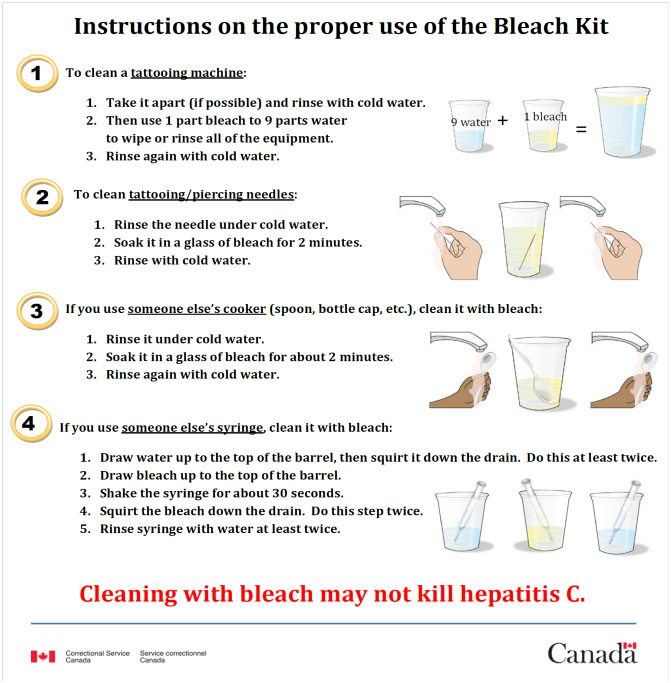Commissioner's directive 800-6: Bleach Distribution
Authorities
Purpose
To promote public health and a safe and healthy environment through the provision of bleach kits to inmates as a harm reduction measure against the transmission of HIV and other infectious diseases
Application
Applies to all staff responsible for the implementation and maintenance of the bleach program in the institution
Guidelines
Table of contents
Responsibilities and Procedures
- The Institutional Head will:
- designate a Workplace Hazardous Material Information System (WHMIS)-trained staff member as the coordinator of bleach distribution for the institution
- encourage participation of inmates and their assistance in the maintenance of bleach distribution.
- The Institutional Head will determine the best mechanism for the replacement of the one-ounce bottles of bleach at the operational unit, in consultation with the institutional coordinator.
- The staff member designated by the Institutional Head as coordinator of bleach distribution will be responsible for ensuring that:
- upon reception, inmates are issued bleach kits, are informed of the locations where bleach is available in the institution, and are instructed on the use of bleach as a harm reduction measure, as well as on first aid measures
- the mechanism for the replacement of bleach, as determined by the Institutional Head, is set in place and is maintained on an ongoing basis
- The bleach distribution dispensing equipment is inspected monthly to ensure it is in good working order.
Contents of Bleach Kits
- Full strength (between 5.25% and 7%) household bleach will be utilized as the disinfecting agent.
- Each bleach kit will consist of:
- one 1-ounce opaque plastic bottle of bleach, labelled with a notice in both official languages reading “Bleach – Do Not Drink or Inject”
- one 1-ounce empty opaque plastic bottle for water
- instructions on the proper cleaning of syringes and needles.
- The caps on the plastic bottles should be screw top type in order to prevent squirting of the contents.
Distribution of Bleach Kits
- Every newly admitted inmate will be issued one bleach kit at reception and will be offered a bleach kit upon transfer to another institution, except:
- where there is reason to believe that the inmate is not capable of understanding how to use bleach as a harm reduction tool
- where there is reason to believe that the inmate may cause injury to themself or to another person through misuse, or
- where the security requirements specific to an operational unit (e.g. Special Handling Unit) preclude making bleach available to inmates.
Replacement of Bleach
- Subject to the above, there will be a minimum of three designated locations in each institution in addition to all private family visiting units where inmates can refill an empty bottle with bleach or obtain a bottle of bleach. Appropriate locations are those affording the inmate privacy to the extent possible. In no instance will an inmate be required to approach a staff member in order to obtain refills.
Education
- Information on the use of bleach as a harm reduction measure will be provided to all inmates at reception and throughout their incarceration, and opportunities to reinforce knowledge through other avenues such as special events and the inmate committee or other inmate groups will be encouraged and supported.
- Printed instructions included in the bleach kits on the proper cleaning of syringes and needles will be available at the locations where bleach bottles are refilled (Annex C – Instructions on the proper use of the Bleach Kit).
When Bleach is Considered Contraband
- An inmate in possession of quantities of bleach in excess of a one ounce bottle is considered to be in possession of contraband unless prior authorization has been obtained.
- The possession of a one ounce bottle of bleach is not in itself sufficient evidence of drug usage or other activity constituting a disciplinary offence.
Safety Precautions
- In consultation with the institutional Workplace Health and Safety Committee, the coordinator of bleach distribution will determine if there is a requirement to install eye-wash stations and will review this matter periodically.
- The Institutional Head will be advised without delay of any incident involving injury to a person from bleach where medical attention has been provided. Such an incident will require completion of an accident report.
- The WHMIS Material Data Sheet will be posted in security posts where there is inmate movement, in the Health Care Centre and in the Post Instructions book.
- A copy of Annex B – First Aid Measures and Other Precautions for the Use of Bleach will be posted in each living unit.
Assistant Commissioner,
Health Services
Original signed by:
Jennifer Wheatley
Assistant Commissioner,
Human Resource Management
Original signed by:
Alain Tousignant
Annex A
Cross-References
- CD 800 – Health Services
- Sexually Transmitted Infection Guidelines
Annex B
First Aid Measures and Other Precautions for the Use of Bleach
Contact with Eyes
In the event that bleach has come into contact with a person’s eyes, that person should flush their eyes thoroughly with lukewarm water for at least 10 minutes while holding the eyelids open and seek medical attention to ensure that there are no burns to the eyes.
Contact with Skin
Where bleach has come into contact with a person’s skin, that person should thoroughly wash the affected area as well as any contaminated clothing.
Ingestion
In the event that bleach has been ingested by a person, that person should drink warm water or milk and seek medical attention. Vomiting must not be induced.
Inhalation
In the event that bleach has been inhaled by a person, that person should be moved to an area with fresh air and medical attention should be sought.
Injection
In the event that bleach has been injected by a person, that person should be assessed by a health care professional and treated appropriately.
Annex C


Page details
- Date modified:
